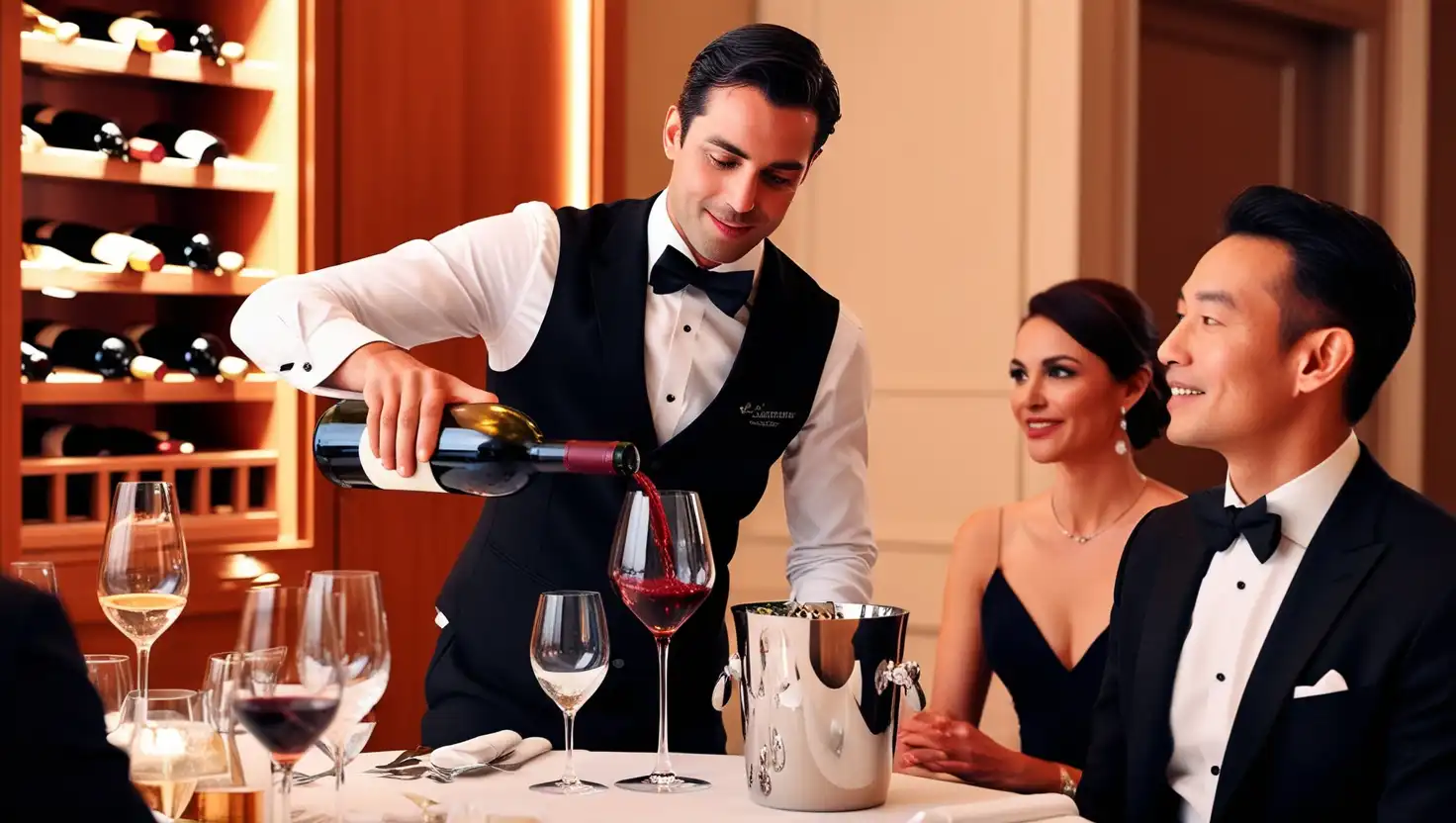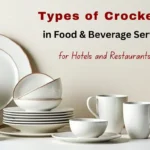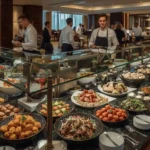Wine service is a crucial skill in the food and beverage industry, requiring expertise, precision, and etiquette. Proper wine service not only enhances the guest experience but also showcases professionalism and ensures that each wine is enjoyed at its best. A sommelier, or a well-trained server, is responsible for guiding guests through wine selection and service, ensuring perfect pairings with their meals.
This guide provides a step-by-step wine service procedure, covering essential techniques for serving red, white, and champagne wines. From selecting the right glassware and serving temperature to handling the bottle and pouring correctly, mastering these techniques will elevate your wine service skills and enhance customer satisfaction.
Essential Factors in Wine Service
Proper wine service enhances the guest experience and preserves the wine’s quality. Attention must be given to the following key factors when serving wine:
- Right Glassware – Using the correct glass enhances the aroma and taste.
- Right Temperature – Serving wine at the ideal temperature ensures optimal flavor.
- Proper Handling of the Bottle – Careful handling prevents sediment disturbance and maintains quality.
- Right Quantity – Pouring the correct amount allows proper aeration and appreciation.
- Essential Wine Service Equipment – it is crucial to have the necessary tools
1. Right Glassware
Selecting the appropriate glassware is crucial for enhancing the wine’s aroma and taste. The ideal wine glass is plain, thin, and made of clear glass to allow full appreciation of the wine’s color and clarity. Wine glasses typically have a stem to prevent heat transfer from the hand and a bowl that tapers inward to concentrate the aroma.
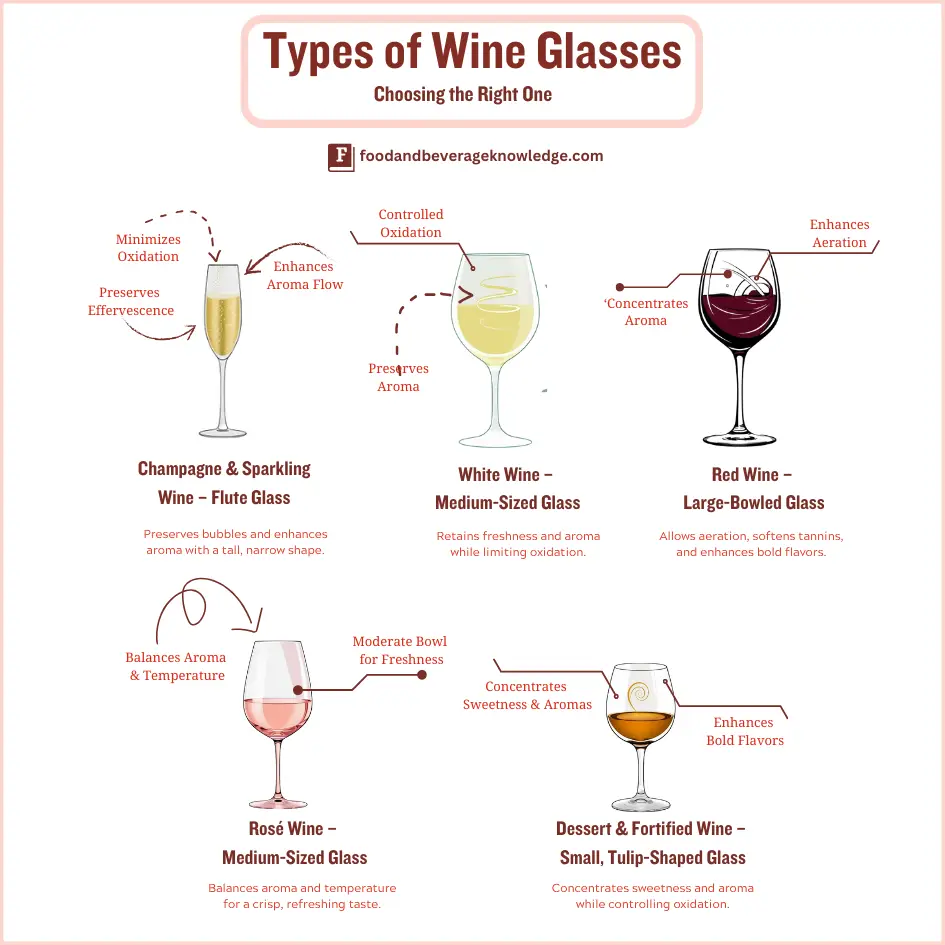
Here are the recommended glasses for different types of wine:
- Champagne & Sparkling Wine – Flute or tulip-shaped glass to preserve effervescence.
- White Wine – Medium-sized wine glass to retain freshness and aroma.
- Red Wine – Large wine glass (10 fl oz or more) to allow aeration and aroma concentration.
- Rosé Wine – Flute or medium-sized wine glass to balance aroma and temperature.
- Dessert Wine – Small, narrow glass to concentrate sweetness and aroma.
- Fortified Wine (e.g., Port, Sherry, Madeira) – Small, tulip-shaped glass to enhance bold flavours.
- Burgundy (Pinot Noir) – Wide-bowled glass to enhance complex aromas and aeration.
- Bordeaux (Cabernet Sauvignon, Merlot) – Tall, large-bowled glass to balance tannins and bouquets.
2. Right Temperature
Wine is best enjoyed at its optimal serving temperature, which enhances its bouquet, flavor, and mouthfeel. Below are the recommended temperatures for various wine types:
Red Wine
- Vintage Port, Bordeaux, Cabernet Sauvignon: 60-65°F (16-18°C)
- Burgundy, Chianti, Shiraz, Barolo: 54-62°F (12-17°C)
- Light Reds (Beaujolais, Loire, Pinot Noir): 50-55°F (10-15°C)
White Wine
- Dry White Wine (Sauvignon Blanc, Pinot Grigio): 45-50°F (7-10°C)
- Full-bodied White Wines (Chardonnay, Viognier): 50-55°F (10-15°C)
- Sweet White Wines (Riesling, Sauternes, Moscato): 40-50°F (4.5-10°C)
Rosé & Sparkling Wines
- Rosé Wine: 45-50°F (7-10°C)
- Champagne & Sparkling Wines: 40-50°F (4.5-10°C)
Serving wine at the right temperature ensures that aromas are not masked, acidity is balanced, and flavors are fully appreciated.
3. Proper Handling of the Bottle
Handling wine bottles correctly maintains the integrity of the wine and prevents unnecessary oxidation or sediment disturbance.
- Red Wines with Sediment – Handle gently to avoid disturbing sediment. Older wines may require decanting.
- White Wines – Served chilled in a wine cooler or ice bucket to maintain the correct temperature.
- Champagne & Sparkling Wines – Served in a champagne cooler or ice bucket to preserve effervescence.
Always present the bottle with the label facing the guest and open it smoothly to avoid disturbing the wine.
4. Right Quantity
Pouring the correct quantity of wine is essential for proper aeration, swirling, and enjoyment. The standard wine pour varies depending on the establishment’s policy, but general guidelines include:
White & Sparkling Wine – Fill no more than ⅔ of the glass to retain freshness.
Standard wine glass pour: 125 ml (4.2 oz)
Red Wine – Fill ½ of the glass to allow swirling and bouquet appreciation.
5. Essential Wine Service Equipment
Before serving wine, ensure you have the following essentials:
- Wine List – Helps guests choose their preferred wine.
- Corkscrew – Waiter’s friend or lever-style for opening bottles.
- Wine Glassware – Specific glasses for red, white, and sparkling wines.
- Decanter – Used for aerating certain red wines.
- Wine Bucket with Ice – Keeps white and sparkling wines chilled.
- Clean Napkins – For wiping and presenting the bottle.
- Serving Tray – Assists in carrying glasses and bottles efficiently.
Also read our complete guide on: 16 Highly Used Wine Grape Varieties and Their Growing Regions
Enhance your wine service skills with this visual step-by-step guide to professional wine service in fine dining. Watch the full video below for clear demonstrations of red, white, and sparkling wine service techniques.
Wine Service Procedure Step by Step
This section outlines the general steps for serving wine in a restaurant or hospitality setting. While these steps apply broadly, different wines—such as red, white, and champagne—require specific handling techniques. Factors like temperature, glassware, and pouring methods vary accordingly.
The below sections will cover specialized service procedures for each type of red, white and champagne.
First, see the infographic below to better understand the wine service procedure before diving into the detailed steps.
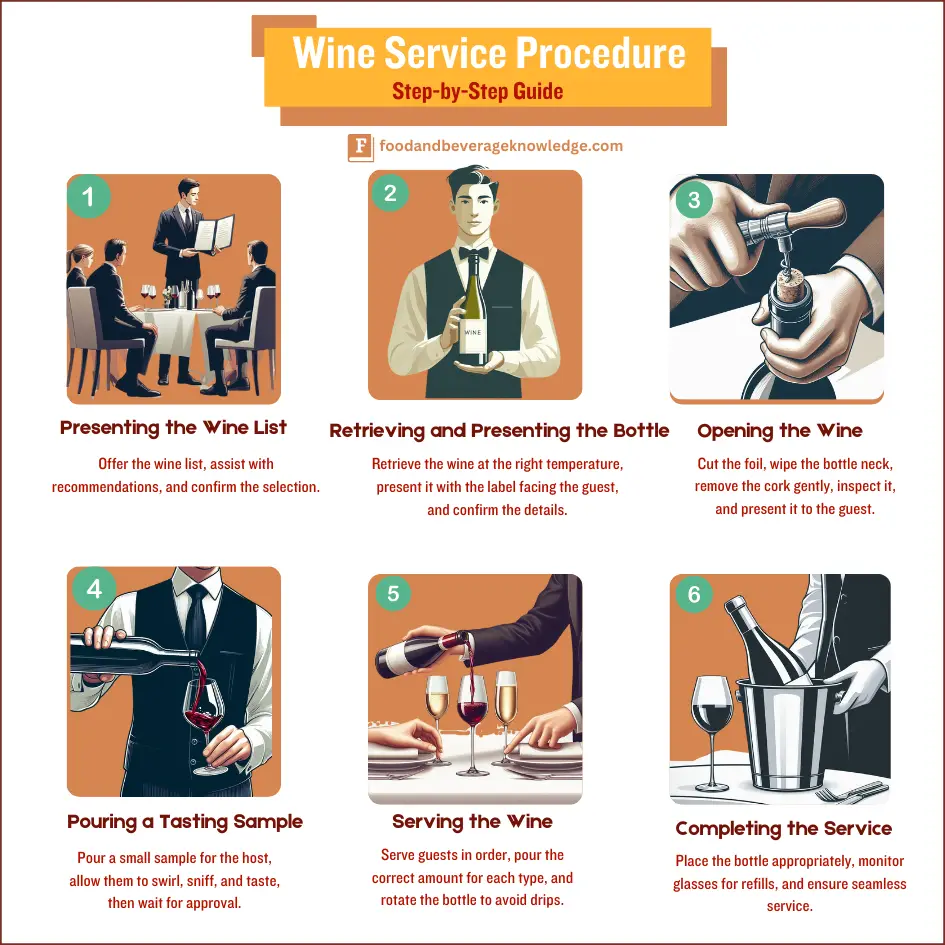
1. Presenting the Wine List
- Offer the wine list to the guests, allowing them time to choose.
- Answer any queries about wine recommendations based on food pairings and preferences.
- Confirm the selection with the guest before proceeding.
2. Retrieving and Presenting the Bottle
- Retrieve the chosen wine from the cellar or storage, ensuring proper temperature.
- Hold the bottle with the label facing the guest who ordered it.
- Announce the wine’s name, vintage, and producer to confirm selection.
3. Opening the Wine
- Stand at the guest’s right side or the designated service position.
- Cut the foil below the bottle’s lip using a foil cutter or corkscrew knife.
- Wipe the bottle’s neck with a clean napkin.
- Insert the corkscrew and gently remove the cork without making a loud “pop.”
- Inspect the cork for signs of damage or spoilage and present it to the guest.
- Wipe the bottle’s rim again to ensure cleanliness.
4. Pouring a Tasting Sample
- Pour a small amount (1-2 ounces) into the host’s glass for tasting.
- Allow the guest to swirl, sniff, and taste the wine.
- Wait for approval before proceeding with service.
5. Serving the Wine
- Pour wine into each guest’s glass, starting with ladies, followed by gentlemen, and ending with the host.
- Maintain a pouring distance of about one inch above the rim.
- Fill glasses appropriately:
- Red wine: 1/3 full
- White wine: 1/2 full
- Champagne: 2/3 full
- Rotate the bottle slightly at the end of the pour to avoid drips.
6. Completing the Service
- Place the bottle on the table or in a wine bucket as per the type of wine.
- Monitor guests’ glasses and refill them as necessary.
- Provide a seamless experience by being attentive yet unobtrusive.
Related: Sequence of service in restaurants/ restaurant service procedure
Red Wine Service Procedure
1. Temperature Consideration
- Serve red wines at 55-65°F (13-18°C), slightly below room temperature.
- If needed, place the bottle in a wine chiller for a few minutes before service.
2. Decanting (For Aged Reds)
- If decanting is required, pour the wine slowly into a decanter, stopping when sediment appears.
- Allow the wine to breathe before serving.
3. Serving Glassware
- Use a wide-bowled glass to enhance aeration and aromas.
- Serve in the proper sequence, with lighter reds before full-bodied ones.
4. Pouring and Refilling
- Pour carefully, ensuring the correct amount in each glass.
- Monitor refills while respecting guests’ pace and preferences.
White Wine Service Procedure
1. Chilling the Wine
- Serve white wines at 45-55°F (7-13°C).
- Store the bottle in an ice bucket filled with a mix of ice and water.
2. Opening and Serving
- Open the bottle as per the general procedure.
- Pour into appropriate white wine glasses with a narrower bowl to maintain temperature and aromas.
3. Maintaining Temperature
- Keep the bottle in the ice bucket between pours.
- Do not overfill glasses to prevent quick warming.
Champagne and Sparkling Wine Service Procedure
1. Proper Storage and Temperature
- Serve champagne and sparkling wines at 40-50°F (4-10°C).
- Store in a cooler or ice bucket before serving.
2. Opening the Bottle Safely
- Hold the bottle at a 45-degree angle, keeping a firm grip on the cork.
- Remove the foil and loosen the wire cage.
- Hold the cork with one hand while rotating the bottle gently until the cork eases out with a soft pop.
3. Pouring Champagne
- Use flute glasses to preserve bubbles and aromas.
- Pour slowly to avoid excessive foaming, filling the glass in two stages.
4. Serving and Storage
- Keep the bottle in the ice bucket when not in use.
- Refill glasses gently to maintain the effervescence.
Additional Wine Service Tips
- Pairing Recommendations: Suggest complementary food pairings to enhance the dining experience.
- Glass Handling: Hold glasses by the stem to avoid warming the wine.
- Guest Interaction: Engage with guests by providing brief tasting notes and wine stories.
- Wine Waste Management: Dispose of unfinished bottles as per restaurant policies.
Conclusion
Mastering the wine service procedure ensures an elegant and enjoyable experience for guests. By following these detailed steps and understanding the nuances of red, white, and champagne service, food and beverage professionals can elevate their expertise and enhance customer satisfaction. Proper wine service not only adds sophistication to dining but also strengthens an establishment’s reputation in the hospitality industry.
Related:
- 19 Popular Wine and Cheese Pairings: Matching Reds, Whites, and More
- What is a fortified wine, type, service
- Wine tasting basic steps
- The Ultimate Guide to Wine Types: Exploring Varieties, Styles, and Characteristics
Subscribe and join our community of hospitality professionals & students — get insights, tips, and the latest updates delivered straight to your inbox!

